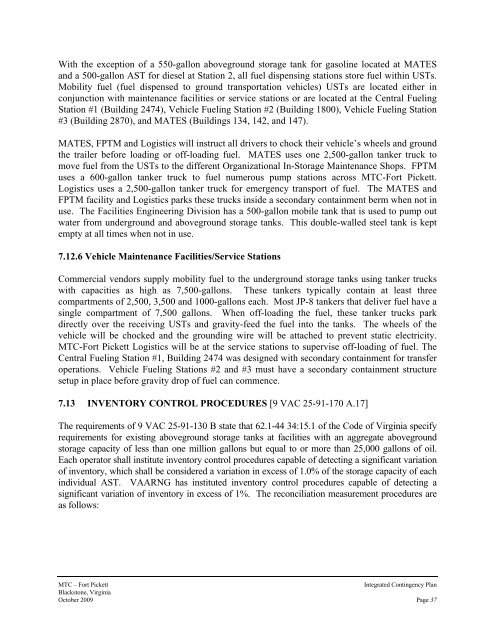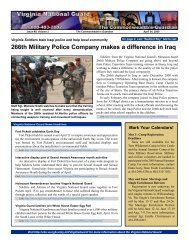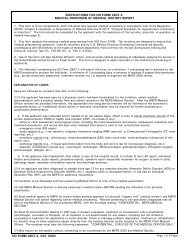INTEGRATED CONTINGENCY PLAN Maneuver Training Center
integrated contingency plan maneuver training center fort pickett ...
integrated contingency plan maneuver training center fort pickett ...
- No tags were found...
Create successful ePaper yourself
Turn your PDF publications into a flip-book with our unique Google optimized e-Paper software.
With the exception of a 550-gallon aboveground storage tank for gasoline located at MATES<br />
and a 500-gallon AST for diesel at Station 2, all fuel dispensing stations store fuel within USTs.<br />
Mobility fuel (fuel dispensed to ground transportation vehicles) USTs are located either in<br />
conjunction with maintenance facilities or service stations or are located at the Central Fueling<br />
Station #1 (Building 2474), Vehicle Fueling Station #2 (Building 1800), Vehicle Fueling Station<br />
#3 (Building 2870), and MATES (Buildings 134, 142, and 147).<br />
MATES, FPTM and Logistics will instruct all drivers to chock their vehicle’s wheels and ground<br />
the trailer before loading or off-loading fuel. MATES uses one 2,500-gallon tanker truck to<br />
move fuel from the USTs to the different Organizational In-Storage Maintenance Shops. FPTM<br />
uses a 600-gallon tanker truck to fuel numerous pump stations across MTC-Fort Pickett.<br />
Logistics uses a 2,500-gallon tanker truck for emergency transport of fuel. The MATES and<br />
FPTM facility and Logistics parks these trucks inside a secondary containment berm when not in<br />
use. The Facilities Engineering Division has a 500-gallon mobile tank that is used to pump out<br />
water from underground and aboveground storage tanks. This double-walled steel tank is kept<br />
empty at all times when not in use.<br />
7.12.6 Vehicle Maintenance Facilities/Service Stations<br />
Commercial vendors supply mobility fuel to the underground storage tanks using tanker trucks<br />
with capacities as high as 7,500-gallons. These tankers typically contain at least three<br />
compartments of 2,500, 3,500 and 1000-gallons each. Most JP-8 tankers that deliver fuel have a<br />
single compartment of 7,500 gallons. When off-loading the fuel, these tanker trucks park<br />
directly over the receiving USTs and gravity-feed the fuel into the tanks. The wheels of the<br />
vehicle will be chocked and the grounding wire will be attached to prevent static electricity.<br />
MTC-Fort Pickett Logistics will be at the service stations to supervise off-loading of fuel. The<br />
Central Fueling Station #1, Building 2474 was designed with secondary containment for transfer<br />
operations. Vehicle Fueling Stations #2 and #3 must have a secondary containment structure<br />
setup in place before gravity drop of fuel can commence.<br />
7.13 INVENTORY CONTROL PROCEDURES [9 VAC 25-91-170 A.17]<br />
The requirements of 9 VAC 25-91-130 B state that 62.1-44 34:15.1 of the Code of Virginia specify<br />
requirements for existing aboveground storage tanks at facilities with an aggregate aboveground<br />
storage capacity of less than one million gallons but equal to or more than 25,000 gallons of oil.<br />
Each operator shall institute inventory control procedures capable of detecting a significant variation<br />
of inventory, which shall be considered a variation in excess of 1.0% of the storage capacity of each<br />
individual AST. VAARNG has instituted inventory control procedures capable of detecting a<br />
significant variation of inventory in excess of 1%. The reconciliation measurement procedures are<br />
as follows:<br />
MTC – Fort Pickett<br />
Integrated Contingency Plan<br />
Blackstone, Virginia<br />
October 2009 Page 37
















